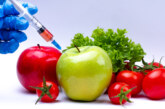As the world’s #population grows, the intensification and #industrializationofagriculture and #animalproduction to meet increasing demand for food creates both opportunities and challenges for #foodsafety. #Climatechange is also predicted to #impactfoodsafety, where temperature changes modify food safety risks associated with #foodproduction, #storage and #distribution.
According to #WHODirectorGeneralDrMargaretChan “Food production has been industrialized and its trade and distribution have been #globalized”. “These changes introduce multiple new opportunities for food to become contaminated with harmful #bacteria, #viruses, #parasites, or #chemicals.” He also add “A local #foodsafetyproblem can rapidly become an international emergency. Investigation of an outbreak of #foodbornedisease is vastly more complicated when a single plate or package of food contains ingredients from multiple countries.”
Millions of litters of #untreatedsewagewater and #industrialwastewater with effluents enter the major #rivers daily, thereby polluting it with toxic chemicals and high level of #coliform and other bacteria. The high level of coliform bacteria increases the incidence of #waterbornediseases. Un safe food containing #harmfulbacteria, #viruses, #parasites or #chemicalsubstances is responsible for more than 200 diseases, and is linked to the deaths of some 2 million people annually, mostly children. Changes in #foodproduction, #distribution and #consumption; changes to the #environment; new and emerging pathogens;
#Malnutrition
Food is vital to our lives, like air and water, providing pleasure and much more. The first food a human being consumes—breast milk—is one of the safest for newborn babies, providing all essential nutrients, offering immunological protection, and creating an emotional bond between mother and child. All foods introduced later belong to our respective cultures. For decades, #WHO has advocated safe and hygienic practices for food preparation.
Despite progress in reducing under nutrition, our planet’s population is still affected by many food-related challenges, including vitamin and #mineraldeficiencies, obesity, and non-communicable diseases. These challenges are fuelled, in part, by cheap, convenient, and highly-processed foods that are appealing to the taste. But food threats do not stop there. One area to which the international community has given substantial, but less visible, attention is ensuring the safety from infection and contamination of the food we produce, trade, and eat.
That food must be nutritious—and safe. Yet food safety is a hidden, and often overlooked, problem. Most people suffering from diarrhoea do not consult a physician. Diseases and deaths might be attributed to other causes, even when the food that people have eaten is the culprit. How often do we hear the phrase “It must be something I ate”? Food borne diseases caused either by an acute infection with a pathogen or by chronic exposure to chemicals, are largely under-reported. Nobody has precise figures on their societal effect. All we know is that the most vulnerable populations, infants and elderly people, are increasing in number, and hence the pool of those people at greatest risk of disease is expanding. A global scandal is often needed to stir the collective consciousness on food safety, such as the bovine spongiform encephalopathy crisis in the 1990s or the adulteration of milk with melamine in 2008, which hit some countries badly. The threat of food safety is then largely forgotten until the next emergency. It is high time for a sustainable response to the core problems, which are fragmentation of food safety authorities, unstable budgets, and a dearth of convincing evidence on the effect of food borne diseases.
The #FoodSecurityBill (FSB) fails to address the problem of malnutrition, especially among the children. On the one hand, India’s economy has been growing at 6-9% for over decade now; on the other hand, under nutrition among children has dropped a mere 1% in the eight-year period 1998-99 to 2006. Should we accept a token 0.1% decline in childhood hunger per year? There is a need to understand that underfed people are unable to contribute, even if provided with opportunities, because of lack of capability. Therefore, there is need to build an environment of empowerment with nutritional security.
Prevalent levels of malnutrition result in a 2-3% decline in GDP. It causes delays in education, triggers learning disabilities, affects the overall physical and cognitive development of children at an early age. Every year, India loses 1.3 million children under the age of 5 due to under nutrition and non-availability/inaccessibility to basic healthcare.
All these factors are at the root of hunger. Professor Arjun Sengupta, in his report on the unorganised sector, mentions that 77% of India’s population survives on Rs 20 a day. On the other hand, #NNMB (National Nutrition Monitoring Bureau) figures show that 76.8% of the population does not receive the prescribed amounts of nutrition!
India contributes 40% to the world’s overall maternal, neo-natal, infant and child deaths. It has half the world’s undernourished children. Fifty-four per cent of women in the country suffer from anemia. There is need to end this ‘domestic variety of colonialism’ where corporations rule over our farmers and labourers and traders indulge in the business of education and health services and keep people deprived of the very basic services in the name of growth. The resources generated through growth should go towards the wellbeing of all people. Not to subsidise corporations.
#WHO is dedicate its 2015 #WorldHealthDay to food safety, to catalyse collective government and public action to put measures in place that will improve safety of food from farms, factories, street vendors, and kitchens. Also in 2015, WHO will, for the first time, publish estimates of the global burden of food borne disease, finally showing the scale of the problem.2 new methods will allow countries to estimate their own food borne disease burdens to inform policies and mobilise badly needed resources.
Today, the food chain extends over thousands of kilometers, crossing many national borders, and containing many steps from production to consumption. An error by a food producer in one country can affect the health of consumers on the other side of the planet. In our globalised world, not only people but foods, as well, travel far and fast. WHO is working to ensure access to adequate, safe, nutritious food for everyone. The Organization supports countries to prevent, detect and respond to food borne disease outbreaks—in line with the Codex Alimentarius, a collection of international food standards, guidelines and codes of practice covering all the main foods.
Food safety, nutrition and food security are inextricably linked. Unsafe food creates a vicious cycle of disease and malnutrition, particularly affecting infants, young children, elderly and the sick.
#NeedforHolisticApproach
Safe food supplies support national economies, trade and tourism, contributes to food and nutrition security, and underpins #sustainabledevelopment.
The global warming and climate change pose a big threat to food production in India. As pointed out by Dr Swaminathan, “It is now clear that the mean temperature may rise by at least 2 degrees centigrade during the next few decades. Adverse changes in temperature, precipitation and sea level are all causes for concern. Both anticipatory research to checkmate the adverse consequences of climate change, and participatory research with farming families for developing adaptation and mitigation measures will be important.”
Ensuring adequate food security and safety ordains inter-sectoral convergence. There is an annual tug of war between the ministries of food and agriculture. The former, as the purchaser, does not want the MSP increased. The latter, representing farmers, insists that it must be. Synergy between various ministries including health at the Centre and between the Centre and the states is a sine qua non for effective implementation of the provisions of the FSB for sustainable food security and safety.
As water and energy are essential for food production, hence water-energy-food nexus approach assumes tremendous significance in ensuring food security. This approach calls for coordination, cooperation and convergence between various ministries and the FSB in its present form does not emphasize on this aspect.
#IsFoodSecurityacttheAnswer?
Climate change can have both direct and indirect human health impacts. Direct impact is heat and cold related stress. Indirect impacts arise from changes in temperature patterns, which may disturb natural ecosystems, change the ecology of infectious diseases, harm agriculture and fresh water supplies, exacerbate air pollution levels, and cause large-scale reorganization of plant and animal communities.
Challenges like absence of convergence, yawning gaps in the formulation and implementation of policies and lack of collective approach to address Health Water Sanitation sectors can be transformed into opportunities through judicious management of these sectors with the help of local communities and the civil society. World Health Day 2015, the theme is “From Farm to Plate Make Food Safe”. Safe food underpins but is distinct from food security. Food safety is an area of public health action to protect consumers from the risks of food poisoning and food borne diseases, acute or chronic.
Unsafe food can lead to a range of health problems: diarrhoeal disease, viral disease (the first Ebola cases were linked to contaminated bush meat); reproductive and developmental problems, cancers etc. So, food safety is thus a prerequisite for food security.
Conclusion
Consequently, a new paradigm is required to focus on rational and judicious use of these resources with adequate emphasis on water-energy-food nexus approach, synergy between the major implementing agencies with a deep sense of commitment, transparency and accountability. Adequate storage and systematic distribution infrastructure is the need of the hour. There is also need for convergence of traditional and modern methods of storage.
India is endowed with natural resource abundance, especially in terms of land and water. However, the onus for failure to turn these endowments into sustained wealth for the well-being of the people lies with the government and agencies assigned with the task to extract natural resources, to instigate change.
By #DrArvindKumarPresidentIndiaWaterFoundation



